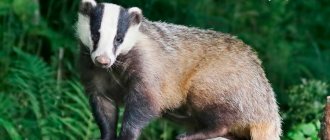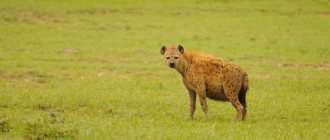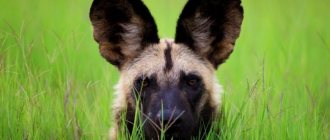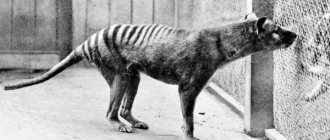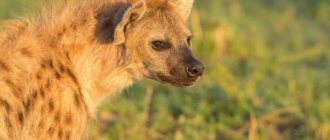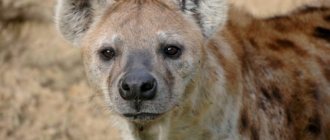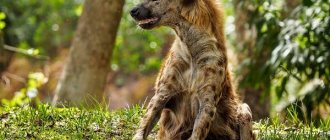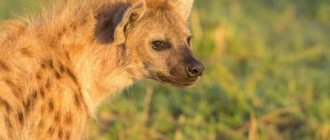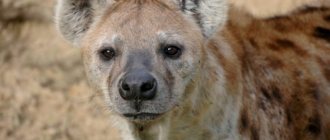Few people associate the hyena with a pet that gently licks the hands of its owner. This is a formidable and predatory animal, which is also a scavenger. Is it possible to tame such an animal, much less keep it at home?
Features of behavior
Hyenas have unique sound characteristics. The terrible laughter that terrifies people is not a mockery, but just a joyful announcement to one’s clan about the discovery of food. Such a cry is often answered not only by family members, but also by enemies - lions. Therefore, they often have to leave with nothing and look for other places for food.
Hyenas are very important animals. They are real orderlies of the African savannahs. Nature has endowed them with rare resistance to various microorganisms. For example, in the 80s there was an anthrax outbreak, 4 thousand hippos died. The hyenas ate the infected corpses, stopping the further spread of the epidemic. Thanks to their unique jaws and stomach, they can chew and eat horns, hooves, and skeletons of dead animals, thereby clearing the African savannas of garbage.
At the ends of hyenas' paws there are glands that produce a disgusting-smelling secretion. By smell, predators cleverly identify individuals of their clan.
Appearance description
Wild dogs are close relatives of red wolves. They look very unusual:
The fur of a hyena dog is coarse and sparse, and in places the skin is visible underneath it. The peculiarity of the breed is its color: it is unusually variegated: spots of sand, black, red and white are located randomly. There are no dogs with the same color. The animals' muzzle and ears are always black. Sometimes there are individuals with pure black fur. Due to actively working sebaceous glands, dogs have a sharp, specific musky odor.
Behavior of hyenas in a pack
Most hyena species live in clans (20-100 individuals). In the wild, males usually predominate over females, but this is not all about hyenas. They have absolute matriarchy.
The hierarchy is built in an unusual way:
- The eldest female hyena is the most privileged. It is she who eats the prey first and takes a break from the African heat in the best place in the hole. The main female determines the role of each clan member in the pack.
- Privileged females are among the first to eat after the main female and occupy VIP places in the hole.
- Females of a lower class. They rest a little away from the privileged females and start dinner after them.
- Males. This is the lowest class. They are the last to be allowed to eat.
The status of female hyenas can be easily determined by the position of their tail. The higher he is, the higher position she occupies in the clan.
The female queen carefully ensures that the borders of the territory are guarded by a “patrol”. Their task is to notify the flock of the approach of “strangers”. In addition, those on duty mark the boundaries with their “fragrant” secretions. The disgusting smell notifies other predators that the territory is under protection.
Breeding offspring
For quite a long time, people believed that spotted hyenas were hermaphrodites, and were confident that they practiced homosexual mating and gave birth using a unique reproductive system. In fact, male spotted hyenas are born males and remain males, and the same is true for females. True, it is quite difficult for people to distinguish representatives of this species from each other, since the genitals of females completely copy the genitals of males. And all because the clitoris of female hyenas of this species is quite large and often reaches 15 cm (the higher the position in the pack the female occupies, the larger it is), and the labia form a sac-like fold, similar to a scrotum. Since the female does not have a vagina, she not only mates, but also gives birth through the clitoris. Reproduction is quite difficult, since this process is painful and complex; childbirth, especially the first, often lasts for hours, which is why half of the puppies die from suffocation, and the female herself often dies (according to statistics, about 10% of mothers die during childbirth).
Animal babies
Interestingly, the female chooses her own partner. This is always a male of high rank, often from another clan, thus these animals avoid inbreeding. Pregnancy lasts about one hundred days, and few cubs are born - from one to three. The female hyena is a very caring mother: she sets up a den in advance (mostly for this purpose she digs a hole on her own or finds a suitable cave), and takes care of her brood for up to two years, feeding them with milk for almost twenty months. Milk is so nutritious that, if necessary, a hyena cub can go without any other food for about a week. Babies are born covered with uniform hair, fully sighted, with fangs and incisors - and almost immediately begin to defend their place in the sun, rushing at their brother or sister with the aim of biting them to death. They often succeed; about a quarter of the babies die as soon as they appear in this world. After some time, the passion for killing passes, and the surviving cubs learn to exist with each other.
A pack of spotted hyenas
Types of hyenas
Hyenas are similar in appearance to dogs, so many believe that these predators belong to the order Canidae. In fact, they belong to cat-like predators.
In total, there are 5 types of hyenas in nature:
- spotted;
- striped;
- brown;
- aardwolves;
- African hyena.
Note! In the savannas there is such an animal as the hyena dog, but it does not belong to the genus of hyenas. These dogs are the worst enemies of hyenas. Fierce battles take place between them for the right to own this or that territory. The flock with the most animals wins.
spotted hyena
This species is the largest. Body length - 1.3 m, height - 80-95 cm, muzzle - 30-35 cm. An adult male weighs 45-50 kg, a female - 45-65 kg. The largest spotted hyenas live in Zambia, males - 65-67 kg, females - 67-69 kg.
More on this topic: East Glacier vs West Glacier: 6 Key Things You Need to Know
The predator's body is covered with short, pale brown fur with dark spots. The neck is covered with long hair, reminiscent of a light mane. The nose and part of the muzzle are dark in color, as if she was wearing a protective mask.
The shape of the muzzle is wide and short, the neck is thick. There are large round ears on the head. The spotted hyena's body is disproportionate: high shoulders, low hips, hind legs slightly shorter than the front ones. The body itself is supported by thin legs. There are only 4 toes on the paw of the spotted predator.
It may seem that the animal is slow and clumsy due to its peculiar body structure, but this is a misconception. It is these anatomical features that allow the hyena to develop high speed to move impressive distances.
Striped hyena
This type of hyena is smaller in size than the spotted hyena. In size it resembles an ordinary yard dog. Outwardly, it resembles a cross between 4 animals: a wild boar, a wolf, a tiger and a monkey. Monkey face, brindle coloring. The high withers, lowered head and jumping gait give a resemblance to both a wolf and a wild boar. This representative of the hyena family clearly cannot be called beautiful and attractive.
Note! Due to the unusual appearance of striped hyenas, different peoples endowed them with mystical qualities. They are considered totem animals. They are revered as clan protectors.
Striped hyenas do not form clans. They mate and raise up to three young. They differ from their relatives of other species in that they do not make howling sounds. The striped predator makes bubbling sounds, grunts and growls.
Brown hyena
The brown hyena is also called the coastal hyena. It is smaller in size than the spotted one. Body length – from 85 to 150 cm, withers height – 70-85 cm.
Brown members of the family do not have strong differences between the sexes in weight. Both males and females weigh approximately 40-45 kg. Sometimes males are slightly larger than females. Brown hyenas have a long, stiff brown mane that hangs down the sides of their back. This species inhabits the coastal areas of southern Africa.
Aardwolf
The smallest representative of hyenas. Body length – 0.8-1 m, weight – 7-10 kg. The muzzle is narrow, the neck is long. The front legs are higher than the hind legs, like all hyenas. Only its paws have 5 toes, and not 4, like all relatives of other species.
The fur color is yellow-white, paler on the lower parts of the body. There are 5-6 vertical black stripes on the body. The tail and legs are black. The animal's muzzle is also black and practically hairless, its eyes are small. The aardwolf does not have the same jaw as other hyenas. Its teeth are small, blunt (except for the canines) and widely spaced.
More on the topic: Wonderful creation of nature: Moravian Karst
The wolf feeds mainly on termites. But he does not destroy termite mounds, but waits until the insects crawl to the surface, then he licks them off with his sticky tongue.
In the absence of termites, it may feast on other insects or mice.
Aardwolves protect themselves from enemies by a pungent odor released during times of danger. The aroma is so disgusting that even skunks would envy it.
African hyena
The African hyena is the largest representative of hyenas. Her weight is 75-80 kg. It looks like a big dog only with a small head. The muzzle is elongated with two small round ears. The color is yellowish. The entire body is covered with dark spots. The wool is long - up to 7 cm.
By nature, she is hot-tempered and poses a threat to humans.
There are no significant differences in appearance between males and females.
The strength of the African hyena can only be matched by a lion.
Natural enemies of the hyena dog
Wild dingo dog in Australia: where the breed lives
Like any animal living in the wild, the dog hyena has its natural enemies. An interesting fact is that hyenas are one of them. These animals have been at war for many centuries.
The main cause of conflicts is that scavengers take away legitimate prey from canids. Accordingly, this fact does not suit dogs at all, who are born hunters and get their own food.
Another natural enemy are representatives of the cat family - lions and cheetahs. The main reason is that wild dogs are predators, and big cats have always been ruthless towards their rivals.
Well, the most dangerous enemy is man. The fact is that dogs often attacked domestic animals and livestock, while raiding human settlements. This has become another reason that the canine population is rapidly declining.
Lions are the natural enemies of the hyena dog.
Reproduction of hyenas in nature
In hyenas, it is difficult to distinguish the sex of the animal. Due to high testosterone, the female's clitoris resembles the male's genital organ.
Male hyenas have to fight for the female's affections. The winner approaches the hyena very respectfully, tilting his head down, and only with her consent does conception occur.
When females pass by, males give way to them. Only a respectful attitude allows the male to win over the female. If you are lucky and the “queen” pays attention to him, then his status among his peers will instantly increase, he will become a leader.
Hyenas can breed at any time, but more often the pups appear from August to early January. Each species of hyena has its own rules. For example, spotted ones mate with individuals from their own flock, while brown ones have a male mate with a female from another clan.
Population status
Until a certain point, the population of these incredible animals had a fairly wide habitat. Moreover, the size of the flocks could reach up to 100 individuals. Nowadays you rarely see a group of 20-30.
Raccoon dog: what it looks like, keeping it at home
As you can understand, the number of animals is gradually decreasing. The reason is mass shootings, changes in the conditions of their habitual habitat and infection with various diseases. Now this animal is included in the Red Book precisely because of its small numbers. In fact, wild dogs are on the verge of extinction.
Important! The total number of these animals today reaches about 3-5.5 thousand individuals. You can meet them in North and South Africa.
Hyena cubs
The first hyena baby is born 110 days after mating. Typically, a predator gives birth to 2-3 puppies at a time. Each baby weighs about 2 kg at birth. The color of the babies is brown. As puppies grow older, they acquire a darker color.
It is surprising that the cubs are born with open eyes and already developed teeth. A mother hyena breastfeeds her babies for 1.5 years. Children inherit the status of their mother in the clan.
Puppies begin the struggle for leadership from the first day of life; they are ready to kill each other in order to remain the only one. Such aggression is to blame for the high level of testosterone, which is off the charts in newborns. After some time, the hormone level drops and the surviving babies more or less calm down.
Hunting
Hyenas have a strong reputation as scavengers, but this is not an entirely accurate description. Yes, hyenas eat carrion, but they are also amazing hunters.
While hunting, cat-like predators reach speeds of up to 60 km/h. Hyenas hunt in groups or alone, depending on the chosen prey. For example, a springbok antelope is hunted by one hyena, and a wildebeest is hunted by a group of 3 predators. When hunting large animals, hyenas gather in packs. They eat their prey while it is still alive, lowering their jaws into its stomach. The victim has no chance to escape.
Hungry hyenas are very dangerous even for the largest animals: elephants, old lions. When starting to hunt, predators make terrifying sounds - wild laughter that turns into a howl.
More on this topic: Is the Grand Canyon worth traveling?
Animals are most active at night; during the day they usually rest in their burrows.
What does a hyena eat?
Predators from the hyena family eat buffalo, antelope, rhinoceroses, elephants, leopards, zebras, lions, as well as reptiles and insects. Hyenas also attack domestic animals and birds. They eat any carrion. Brown representatives feed on dead fish thrown ashore by the waves.
Many people are interested in what hyenas eat, besides meat and fish. Surprisingly, they happily eat watermelons and melons, seeds and nuts, and vegetables.
Smarter than a chimpanzee
Representatives of the hyena family are distinguished by a high level of intelligence. They are so smart that they surpass even chimpanzees. They easily solve complex problems, and their volume of the frontal cortex can be compared with the volume of the cortex of higher primates.
Interestingly, you can tame not only a baby, but also an adult. They are highly trainable and excellent watchdogs. And now it seems that the hyena is an ideal pet animal, but everything is not so simple.
Domestic hyena, how to keep a hyena at home
Domestic hyenas are famous for their devotion to their owners. Only exotic lovers should weigh the pros and cons a thousand times before getting such a pet.
Only a strong-willed and physically strong person can become the owner of this predator. To earn the devotion and absolute submission of the beast, you must become its leader; a strict hierarchy reigns in the hyena clan. Remember that a hyena has a jaw of steel and even playfully it can cause serious injuries to a person.
Don't forget that hyenas smell disgusting. In nature, animals mark territory using a smelly secretion from glands under their tails. When they see the leader, it is customary for hyenas to turn their rectum outward with all its contents. The predator also likes to wallow in carrion.
The signals emitted by hyenas are also quite unpleasant - laughter and howls. They greet the leader with sounds reminiscent of gagging.
If the decision to get a hyena is final, then the owner needs to provide her with comfortable living. Do not keep a hyena in an apartment; it is better to keep your pet in a country house in a spacious enclosure with strong steel bars. You should take into account the pet’s natural habitat; it likes coolness, but cold does not.
Representatives of the hyena family are quite sociable, the owner will have to pay a lot of attention to the pet. With a lack of entertainment, the predator will hunt all living things very creatively.
Giant dog and man
In nature, these are irreconcilable enemies. Uncontrolled shooting led to the fact that wild dogs almost disappeared as a species. At the same time, this phenomenon is not explained by the fact that the dogs were a source of food or a war trophy. The thing is that dogs have long been considered quite harmful animals that bring a lot of trouble.
Frequent attacks by packs led to the death of livestock. Also, wild dogs were carriers of a large number of diseases. Now, of course, the opinion about these animals has radically changed. They are protected as few in number.
Watching the dogs, the man realized how caring and kind they are towards each other. On the other hand, during hunting, dogs become truly dangerous and deadly predators.
Note! If you take a wild dog puppy into your home and raise it correctly, it may well adapt and become a pet, capable of guarding the territory introduced to it.
Interesting facts about hyenas
- In ancient Egypt, hyenas were bred for meat.
- Predators greet their relatives like dogs.
- Their cubs are born with their eyes open and from the age of one year they hunt with their mother.
- Hyenas are superior in intelligence to even chimpanzees and make decisions instantly.
- Females have higher levels of the male hormone (testosterone) compared to males. Perhaps for this reason matriarchy reigns in the clan.
- The hyena's stomach is capable of digesting even skin and bones.
- The animal is a real terror of the savannas. Powerful jaws allow them to cling to their prey with a death grip. Predators never kill their prey, but eat it alive as they move.
- Hyenas are not cowards, as many people believe. They are capable of taking prey even from a lion. And old weak lions can become their victims themselves.
- There are tribes in Africa who believe that hyenas are messengers of the Sun. They revere these predators more than the leader.
Habitat
The spotted hyena's habitat is quite wide. Animals are found in semi-desert, desert and foothill regions of Africa, as well as in savannas. But striped hyenas also live in Afghanistan, Pakistan, Turkey, Iran and India.
The habitat of spotted individuals extends from the Sahara to the Cape of Good Hope. Predators live in Kenya, Botswana, Congo, Namibia, and in the Ngorongoro crater. In the eastern regions of Sudan and Ethiopia, hyenas are found even at altitudes of more than 4,000 above sea level.
The dangerous predator, the spotted hyena, prefers savannas for a reason, because they are always full of all kinds of animals that are part of the animal’s diet. But in dense tropical forests, predators feel uncomfortable.
